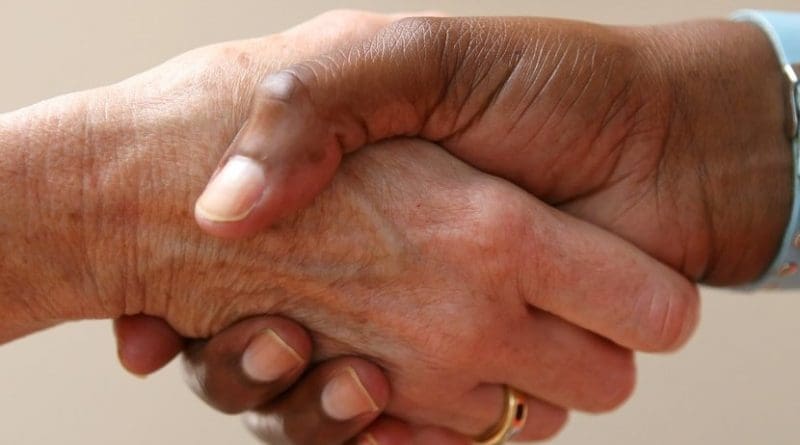The Handshake May Become A Victim Of Coronavirus – OpEd
By Arab News
By Zaid M. Belbagi*
A good, firm handshake is a universal sign of strength and assuredness; an act of mutual respect between two people that is central to the socialization of the human species. All over the world, a meeting of hands, often accompanied by a nod or an embrace, is a central part of communication. In business circles, a good handshake is as much a confirmation of a deal as, in the Islamic tradition, a warm greeting is actually a good deed. This was, of course, until last month, when the world — overcome with the astonishing infectiousness of the coronavirus — began to step back from traditional physical greetings. With mounting evidence suggesting that hand-to-hand contact between people spreads diseases, looking at how the practice came about, and indeed what future it has, is more relevant than ever.
Whether attending an interview or concluding a diplomatic visit, the handshake has become the de facto human greeting. Being such a common gesture, very little thought is given as to why.
Perhaps unsurprisingly, one of the first recorded handshakes was in the Middle East. On King Shalmaneser III’s throne, a carving shows the 9th century B.C. Assyrian ruler shaking hands with a Babylonian leader following the conclusion of an alliance. In this early instance, the handshake was the public manifestation of an agreement between two peoples. Such customs grew to become more popular in the ancient world. In the Pergamon Museum in Berlin, a funeral stone from the 5th century B.C. shows two soldiers shaking hands. The gesture, one of openness and comfort, supports the historical assumption that it evolved as a sign of good faith.
Because a handshake involves the presentation of an open right hand, it indicates trust as it proves the absence of a concealed dagger or other sidearm. With a sword sheathed, shaking hands prevents it from being drawn. In Roman times, the handshake was in reality a forearm grab — again to check that the other party didn’t have a knife hidden up their sleeve.
The practice, however, ultimately became more widespread as a symbol of friendship and loyalty. It became so ubiquitous that pairs of clasped hands even appeared on Roman coinage. In Medieval Europe, knights would shake each other’s hands in an attempt to loosen any weapons concealed in their rival’s armor. In martial societies, where sidearms were commonplace, the necessity of such a vigorous salutation was no doubt necessary, but it wasn’t until the early modern period that it became internationally understood and used as a greeting.
In 17th century England, the Quakers, who rallied against excess and unnecessary practices, popularized the handshake as a more egalitarian alternative to bowing or tipping a hat. The custom grew in popularity and, by the 19th century, it became the most common form of greeting, both as a formal politesse and an act of warmth in the otherwise incredibly rigid Victorian society.
The handshake as we know it really came into its own during the Victorian Age. Modern handshake etiquette developed during the 19th century and, by 1900, it was the most common method used to greet others. Countless guides were offered as to the best way to shake hands, perhaps among the most memorable being, from 1877: “A gentleman who rudely presses the hand offered him in salutation, or too violently shakes it, ought never to have an opportunity to repeat his offense” — a transgression that is still unfortunately made to this day.
The British custom truly went worldwide alongside rail travel and Cadbury’s chocolates, propelled by the country’s far-flung empire. Despite the trend, local practices persisted: The sticking out of tongues in Tibet, the touching of noses in the Gulf states, and the air kiss in Latin America and the Mediterranean, among countless others.
The complete repertoire of human greetings is a living history of interactions by the world’s most social, and indeed successful, species. However, in times of disease, handshakes are mankind’s greatest weakness, given their propensity to act as a conduit for infection. There is no doubt that current circumstances have forced many to reconsider how they greet others.
Going forward, it may be that the Malaysian-style placing of a hand on one’s heart or the subcontinental salute known as “Aadaab” may become more logical replacements. Circumstances and human history shaped the modern handshake, but the collective global experience of the coronavirus pandemic may change it forever.
- Zaid M. Belbagi is a political commentator, and an adviser to private clients between London and the Gulf Cooperation Council (GCC). Twitter: @Moulay_Zaid

